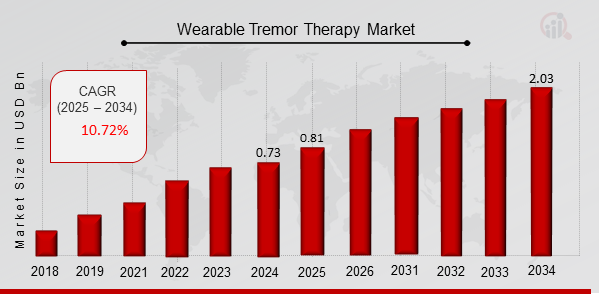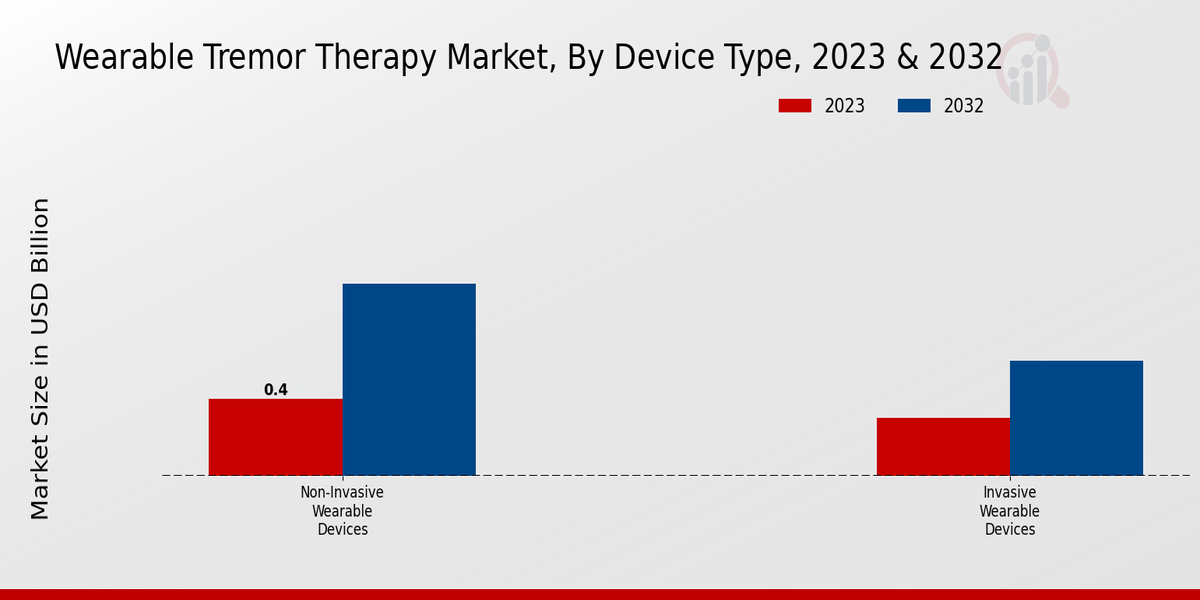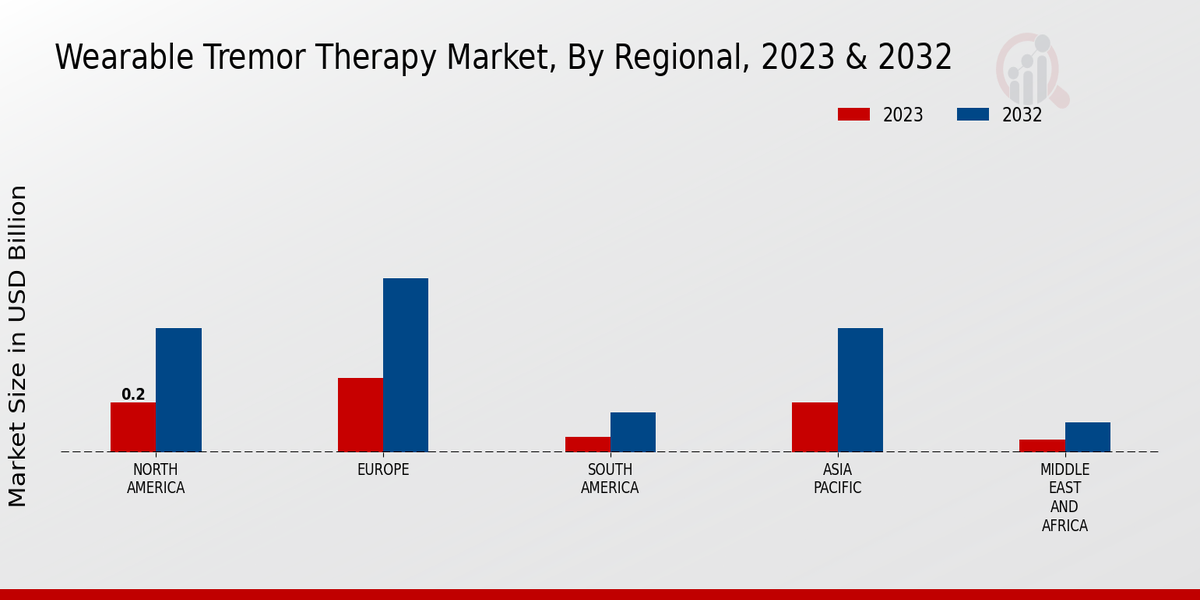Wearable Tremor Therapy Market Overview
As per MRFR analysis, the Wearable Tremor Therapy Market Size was estimated at 0.73 (USD Billion) in 2024. The Wearable Tremor Therapy Market Industry is expected to grow from 0.81 (USD Billion) in 2025 to 2.03 (USD Billion) till 2034, at a CAGR (growth rate) is expected to be around 10.72% during the forecast period (2025 - 2034).
Key Wearable Tremor Therapy Market Trends Highlighted
The Wearable Tremor Therapy Market exhibits steady growth, driven by the increasing prevalence of movement disorders, particularly essential tremors.
Growing awareness of wearable tremor therapy devices, coupled with technological advancements, fuels market expansion. The rising demand for minimally invasive and non-pharmacological treatment options for tremor disorders further contributes to market growth.
Moreover, government initiatives aimed at promoting healthcare accessibility and supporting research and development in this field create opportunities for market players.
Recent trends include the integration of advanced technologies, such as AI and machine learning, into wearable tremor therapy devices to enhance their accuracy and effectiveness.
Additionally, the focus on personalized therapy and telehealth services to improve patient outcomes is expected to shape the future of the market.

Source: Primary Research, Secondary Research, MRFR Database and Analyst Review
Wearable Tremor Therapy Market Drivers
Increasing Prevalence of Neurological Disorders
The growing occurrence of various kinds of neurological conditions like Parkinson’s disease, and essential tremor is the major factor driving the growth of the Wearable Tremor Therapy Market. These diseases are generally characterized by repeated tremors without any voluntary control.
The tremors are discomforting and severely hamper mobility, daily activities, and the quality of life of affected individuals. As a result, the demand for wearable tremor therapy devices is escalating among end-users.
Technological Advancements and Innovation
Technological advancements have revolutionized the Wearable Tremor Therapy Market. The development of advanced sensors, algorithms, and miniaturized devices has enabled the creation of wearable tremor therapy devices that are smaller, more discreet, and more user-friendly.
These devices offer real-time tremor monitoring, personalized therapy programs, and connectivity to healthcare providers, enhancing their effectiveness and accessibility.
Growing Awareness and Acceptance
Increased awareness about wearable tremor therapy and its benefits is driving market growth. As more individuals become aware of the efficacy of these devices in managing tremors, demand is expected to rise.
Medical professionals are also recognizing the value of wearable tremor therapy as a complementary treatment option, leading to wider acceptance and adoption.
Wearable Tremor Therapy Market Segment Insights
Wearable Tremor Therapy Market Device Type Insights
The Device Type segment of the Wearable Tremor Therapy Market is classified into Non-Invasive Wearable Devices, Invasive Wearable Devices. The Invasive Wearable Devices segment accounted for the largest share in the Wearable Tremor Therapy Market.
These devices are more precise and effective than the non-invasive wearable devices as these are directly implanted into the affected areas and deliver therapy to the concerned portion. However, the CAGR of the Non-Invasive Wearable Devices segment is expected to be higher than that of the Invasive Wearable Devices.
This can be attributed to the rising number of the target population that requires non-invasive therapies to eliminate the risk associated with invasive complaints and the comfortable nature of the therapy. In addition to this, the Wearable Tremor Therapy Market is also projected to grow due to increasing hospital and home healthcare adoption in cases of non-invasive devices.
The key factors that will trigger the growth of the Wearable Tremor Therapy Market are the rising prevalence of movement disorders, the increasing target population of old people, and the growing awareness about wearable tremor therapy.

Source: Primary Research, Secondary Research, MRFR Database and Analyst Review
Wearable Tremor Therapy Market Target Indication Insights
Target Indication Segment Insights and Overview The Wearable Tremor Therapy Market is segmented by Target Indication into Essential Tremor, Parkinson's Disease Tremor, Multiple Sclerosis Tremor, and Dystonia Tremor.
Essential Tremor is the most common target indication, accounting for over 50% of the market share in 2023. The Wearable Tremor Therapy Market for Essential Tremor is expected to reach USD 0.8 billion by 2032, exhibiting a CAGR of 11.5% during the forecast period. Parkinson's Disease Tremor is the second largest target indication, with a market share of approximately 30% in 2023.
The market for Wearable Tremor Therapy for Parkinson's Disease Tremor is projected to grow at a CAGR of 10.9%, reaching USD 0.6 billion by 2032.
Multiple Sclerosis Tremor and Dystonia Tremor represent smaller but growing target indications, with market shares of 15% and 5%, respectively, in 2023.
Wearable Tremor Therapy Market Mechanism of Action Insights
The Wearable Tremor Therapy Market is segmented based on Mechanism of Action into Transcutaneous Electrical Nerve Stimulation (TENS), Electrical Field Stimulation (EFS), Functional Electrical Stimulation (FES), and Closed-Loop Stimulation.
TENS is projected to hold the largest market share due to its non-invasive nature and effectiveness in reducing tremor severity. EFS is another promising segment, expected to grow significantly in the coming years owing to its ability to modulate neural activity and improve motor control.
The Closed-Loop Stimulation segment is gaining traction as it offers personalized and adaptive therapy based on real-time tremor data, leading to improved treatment outcomes.
Wearable Tremor Therapy Market Tremor Severity Insights
The Wearable Tremor Therapy Market is segmented by tremor severity into mild tremor and moderate tremor. The mild tremor segment is expected to account for a larger revenue share in the market in 2023 due to the higher prevalence of mild tremors compared to moderate tremors.
The Wearable Tremor Therapy Market revenue for the mild tremor segment is expected to grow at a CAGR of 10.5% from 2025 to 2034, reaching USD 0.8 billion by 2034.
The growth in both segments is attributed to the increasing awareness of wearable tremor therapy devices and the growing adoption of these devices as a first-line treatment for tremors.
Wearable Tremor Therapy Market Sales Channel Insights
Hospitals dominate the Wearable Tremor Therapy Market revenue, holding a significant market share due to the presence of specialized healthcare professionals, advanced medical infrastructure, and high patient footfall.
The increasing prevalence of neurological disorders, such as Parkinson's disease and essential tremor, along with the rising geriatric population, drives the demand for wearable tremor therapy devices in hospitals.
Clinics also capture a substantial market share, owing to their accessibility and convenience for patients seeking specialized treatment for tremor disorders.
Additionally, online retailers are gaining popularity due to the growing e-commerce trend and the availability of a wide range of devices at competitive prices.
Direct-to-consumer sales channels are expected to witness significant growth over the forecast period, driven by increased awareness of wearable tremor therapy devices and the ease of online purchasing.
Wearable Tremor Therapy Market Regional Insights
The regional segmentation of the Wearable Tremor Therapy Market presents distinct market dynamics and growth opportunities.
North America remains a prominent region, accounting for a significant share of the global market revenue in 2023. The region's well-established healthcare infrastructure, high prevalence of neurological disorders, and growing adoption of advanced medical technologies contribute to its market dominance.
Europe follows closely, driven by increasing healthcare expenditure, favorable reimbursement policies, and a large patient population.
The Asia-Pacific (APAC) region is projected to witness substantial growth due to rising disposable income, increasing awareness of wearable health devices, and government initiatives to improve healthcare accessibility.
South America and the Middle East and Africa (MEA) regions are expected to exhibit moderate growth, influenced by varying healthcare infrastructure, economic conditions, and cultural factors.

Source: Primary Research, Secondary Research, MRFR Database and Analyst Review
Wearable Tremor Therapy Market Key Players and Competitive Insights
Leading companies in the wearable tremor therapy market are conducting research and development activities to expand their product portfolio and increase their market share. Due to the presence of several key players, the market is highly competitive.
These companies are increasingly investing in research and development activities or concentrating on product innovations, as well as expanded operations and partnerships to stay competitive. Major companies are striving to deliver better patient results, lower treatment costs, and improve user experiences.
This competitive nature is expected to encourage companies to develop new technologies and solve current challenges, thereby facilitating the growth of the wearable tremor therapy market.
Demand for major companies, Cala Health, in the wearable tremor therapy market is strong.
Cala Health is well-known for its product, the Cala Trio therapy system, in which non-invasive electrical stimulation reduces tremors in people with essential tremors. The product is FDA-approved and has yielded promising clinical trial results.
Cala Health is headquartered in the United States and has expanded its presence in international markets. The company has a strong commitment to cutting-edge innovations and patient satisfaction.
Insightec, which developed the Exablate Neuro line that employs focused ultrasound waves to treat essential tremor, is the main competitor to Cala Health in the wearable tremor therapy market.
The Exablate Neuro system is non-surgical and involves very low levels of side effects. The product has so far yielded highly satisfied patient testimonials.
Insightec is based in Europe and has a strong presence in new markets around the globe while simultaneously investing in research and development and forging partnerships with major healthcare providers.
Key Companies in the wearable tremor therapy market Include
- Neuroelectrics
- Novocure
- NeuroPace
- OvuSense
- Stimwave Technologies
- Kernel
- Cala Health
- Insightec
- Ceribell
- Sonomed Escalar
- Pacira Biosciences
- Renishaw
Wearable Tremor Therapy Market Developments
The rising prevalence of movement disorders, growing demand for non-invasive and effective treatment options, and technological advancements in wearable devices are key factors driving market growth.
Strategic partnerships and collaborations among market players are also contributing to the market's expansion.
For instance, in 2023, Cala Health and the University of California, San Francisco, announced a collaboration to develop and commercialize a new wearable device for treating essential tremors.
Additionally, government initiatives and funding for research and development in wearable tremor therapy are expected to further boost market growth in the coming years.
Wearable Tremor Therapy Market Segmentation Insights
Wearable Tremor Therapy Market Device Type Outlook
- Non-Invasive Wearable Devices
- Invasive Wearable Devices
Wearable Tremor Therapy Market Target Indication Outlook
- Essential Tremor
- Parkinson's Disease Tremor
- Multiple Sclerosis Tremor
- Dystonia Tremor
Wearable Tremor Therapy Market Mechanism of Action Outlook
- Transcutaneous Electrical Nerve Stimulation (TENS)
- Electrical Field Stimulation (EFS)
- Functional Electrical Stimulation (FES)
- Closed-Loop Stimulation
Wearable Tremor Therapy Market Tremor Severity Outlook
- Mild Tremor
- Moderate Tremor
Wearable Tremor Therapy Market Sales Channel Outlook
- Hospitals
- Clinics
- Online Retailers
- Direct-to-Consumer
Wearable Tremor Therapy Market Regional Outlook
- North America
- Europe
- South America
- Asia Pacific
- Middle East and Africa
| Report Attribute/Metric |
Details |
|
Market Size 2024
|
0.73 (USD Billion)
|
|
Market Size 2025
|
0.81 (USD Billion)
|
|
Market Size 2034
|
2.03 (USD Billion)
|
|
Compound Annual Growth Rate (CAGR)
|
10.72 % (2025 - 2034)
|
|
Report Coverage
|
Revenue Forecast, Competitive Landscape, Growth Factors, and Trends
|
|
Base Year
|
2024
|
|
Market Forecast Period
|
2025 - 2034
|
|
Historical Data
|
2020 - 2024
|
| Market Forecast Units |
USD Billion |
| Key Companies Profiled |
Neuroelectrics, Novocure, NeuroPace, OvuSense, Stimwave Technologies, Kernel, Cala Health, Insightec, Ceribell, Sonomed Escalar, Pacira Biosciences, Renishaw |
| Segments Covered |
Device Type, Target Indication, Mechanism of Action, Tremor Severity, Sales Channel, Regional |
| Key Market Opportunities |
Increasing prevalence of tremor disorders Technological advancements Growing demand for non-invasive therapies Expanding reimbursement coverage Rising awareness of wearable tremor therapy |
| Key Market Dynamics |
Growing Prevalence of Tremor Disorders Technological Advancements Rising Healthcare Expenditures Increasing Focus on Patient Comfort Government Support for Research and Development |
| Countries Covered |
North America, Europe, APAC, South America, ME |
Frequently Asked Questions (FAQ) :
The Wearable Tremor Therapy Market was worth USD 0.6 billion in 2023.
North America is expected to hold the largest market share in the Wearable Tremor Therapy Market in 2034.
The Parkinson's disease segment is expected to hold the largest market share in the Wearable Tremor Therapy Market in 2034.
Key competitors in the Wearable Tremor Therapy Market include Abbott, Boston Scientific, Medtronic, and St. Jude Medical.
Key challenges faced by the Wearable Tremor Therapy Market include the high cost of devices, lack of reimbursement, and limited awareness.
The Wearable Tremor Therapy Market is expected to reach USD 1.5 billion by 2032.
Asia Pacific is expected to have the highest growth rate in the Wearable Tremor Therapy Market from 2025 to 2034.
Technological advancements are expected to drive growth in the Wearable Tremor Therapy Market by improving the efficacy and accessibility of devices.

















